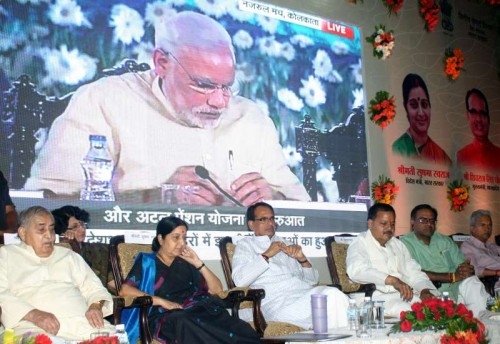
Prime Minister Narendra Modi on launched three ambitious social security schemes, relating to the insurance and pension sector and intended at widening the process of financial inclusion.
On his first visit to West Bengal after taking over as prime minister, he kickstarted the “Pradhan Mantri Suraksha Bima Yojana” (accident insurance), “Pradhan Mantri Jeevan Jyoti Yojana” (life insurance) and “Atal Pension Yojana” at a programme in Nazrul Manch here.
West Bengal Governor K.N. Tripathi, Chief Minister Mamata Banerjee, and union ministers Jayant Sinha and Babul Supriyo attended the function where Modi inaugurated a plaque by pressing a remote button to launch the schemes.
An audio visual film was then shown highlighting salient features of the three schemes. The prime minister then handed out certificates to the first three subscribers – including two women.
The Jan Suraksha Yojana, under which the schemes were launched countrywide, is expected to reduce the number of zero balance bank accounts created under the Jan Dhan Yojana. The schemes target the poor and unorganised sector who are neither covered by any form of insurance nor get pension.
Under the accident insurance scheme, a person will be provided cover of Rs.200,000 for an annual premium of Rs.12. The cover is for accidental death or permanent total disability.
The scheme will be available to people in the age group of 18 to 70 years with a savings bank account, who give their consent to join and enable auto-debit on or before May 31 for the coverage period – June 1 to May 31 – on an annual renewal basis.
The life insurance scheme will offer a renewable one year life cover of Rs.200,000 to all savings bank account holders in the age group of 18 to 50 years, covering death due to any reason, for a premium of Rs.330 per annum per subscriber.
On the other hand, the pension scheme focuses on the unorganised sector and provides subscribers a fixed minimum pension of Rs.1,000, Rs.2,000, Rs.3,000, Rs.4,000 or Rs.5,000 per month starting at the age of 60 years, depending on the contribution option exercised on entering at an age between 18 and 40 years.
Thus, the period of contribution by any subscriber under APY would be 20 years or more.
The benefit of fixed minimum pension enjoys sovereign guarantee.
While the scheme is open to bank account holders in the prescribed age group, the central government would also co-contribute 50 percent of the total contribution or Rs. 1,000 per annum, whichever is lower, for five years.
The government contribution will be for those joining the scheme before Dec 31, 2015, are not members of any statutory social security scheme and are not income tax payers.
It is estimated that the unorganised sector workers, which constitute 88 percent of the total labour force of 47.29 crore, as per the 66th Round of NSSO Survey of 2011-12, do not have any formal pension provision.
The three schemes were simultaneously launched at 112 centres in different states and union territories attended by respective chief ministers/governors and the union ministers.